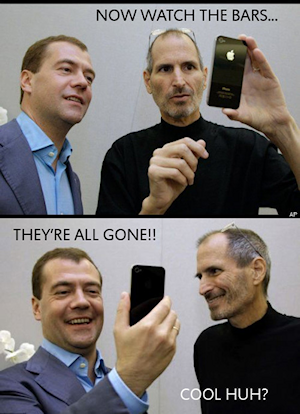Attention: This content is 15 years old. Please keep its age in mind while reading as its contents may now be outdated or inaccurate.
 What happened Apple?
What happened Apple?
You seemed to be on top of the world in design and function. Then you released the iPhone 4.
What a horribly designed piece of hardware. Apple seems to have chosen the “form before function” approach here and the swaths of people who lined up for the next iDevice from old Jobs and gang now feel brutally raped and left out in the cold.
Within hours of the iPhone 4’s release, reports already flooded tech blogs of massive reception issues with Apple’s new heralded antenna design. Apple remained fairly silent on the whole ordeal until last friday when they all but admitted the phone has a fatal flaw… the new antenna system they talked up at the press event.
Apple tried to put a positive spin on the whole thing basically saying it’s not their fault, ALL antenna systems do this, and they even tried to demo the problem in OTHER phones. Well you know what Steve? Explain why the iPhone 4 is the only one dropping calls when held. Other companies are even firing shots across Apple’s bow regarding the design.
Nokia:
Nokia has invested thousands of man hours in studying human behavior, including how people hold their phones for calls, music playing, web browsing and so on. As you would expect from a company focused on connecting people, we prioritize antenna performance over physical design if they are ever in conflict.
In general, antenna performance of a mobile device/phone may be affected with a tight grip, depending on how the device is held. That’s why Nokia designs our phones to ensure acceptable performance in all real life cases, for example when the phone is held in either hand. Nokia has invested thousands of man hours in studying how people hold their phones and allows for this in designs, for example by having antennas both at the top and bottom of the phone and by careful selection of materials and their use in the mechanical design.
RIM:
Apple’s attempt to draw RIM into Apple’s self-made debacle is unacceptable. Apple’s claims about RIM products appear to be deliberate attempts to distort the public’s understanding of an antenna design issue and to deflect attention from Apple’s difficult situation. RIM is a global leader in antenna design and has been successfully designing industry-leading wireless data products with efficient and effective radio performance for over 20 years. During that time, RIM has avoided designs like the one Apple used in the iPhone 4 and instead has used innovative designs which reduce the risk for dropped calls, especially in areas of lower coverage. One thing is for certain, RIM’s customers don’t need to use a case for their BlackBerry smartphone to maintain proper connectivity. Apple clearly made certain design decisions and it should take responsibility for these decisions rather than trying to draw RIM and others into a situation that relates specifically to Apple.
Samsung:
The antenna is located at the bottom of the Omnia 2 phone, while iPhone’s antenna is on the lower left side of the device. Our design keeps the distance between a hand and an antenna. We have fully conducted field tests before the rollout of smartphones. Reception problems have not happened so far, and there is no room for such problems to happen in the future.
HTC:
According to Apple, nearly 0.55% of iPhone 4 customers have been in contact with them regarding reception or antenna issues on the new phone
So what percentage of people have complained [about the Droid Eris Antenna]?
“Approximately .016% of customers”, Eric Lin, the company’s global PR and online community manager exclusively revealed to us before adding that “we have had very few complaints about signal or antenna problems on the Eris”.
If you’re keeping track, that is over 34 times higher than the iPhone 4 complaint rates.
Even Consumer Reports tested and proved the serious issue and rated the iPhone 4 a DO NOT BUY.
So you have the biggest names in phone manufacturing all telling Apple they screwed the pooch on this one. Apple obviously did not test the phone enough in the real world and pushed the device out before it was ready. Apple’s solution to this disaster? A product recall with a fixed design? Nope, you get a free ugly case to wrap around your phone to prevent your hand from coming in direct contact with their magical and revolutionary antenna. Wow. Thanks Apple.
Add on top of this whole Antennagate thing, the fact that the phone’s proximity sensor also seems to be suffering from serious issues, causing people’s phones to hang up, mute, or put calls on hold when the phone is brought up to someone’s face, it’s a wonder if Apple seriously tested this device at all? I think it is pretty apparent they did not.
With Apple’s iOS being quickly hunted down by the mass influx of bad ass Android devices, the iPhone 4’s massive problems could spell big trouble for iOS and it’s now dated and played out interface.
Can you hear me now? No Steve, we can’t.
